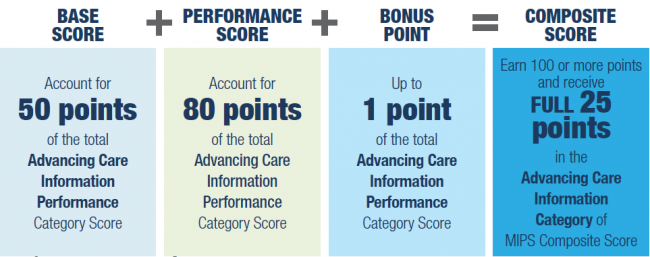Editor’s Note: Subsequent to the publication of this article, CMS has renamed the MIPS “Advancing Care Information” category to “Promoting Interoperability”.
The MACRA legislation established the Medicare Incentive Payment System (MIPS) program. In April 2016 CMS released a proposed rule which defines the MIPS program. MIPS will assimilate the Physician-Medicare version of the Meaningful Use program, change the name to “Advancing Care Information” and shuffle the rules a bit. (Note that the Medicaid version of Meaningful Use will remain and that the Medicare Hospital Meaningful Use program will remain! These will also receive some tweaks.)
Accountability of EHR vendors and care providers
The proposed rule discusses the need for accountability of EHR vendors by implementing additional attestations for Eligible Providers (EPs), Hospitals, and Critical Access Hospitals (CAHs). This provision would require these entities to cooperate with surveillance of CEHRT under the ONC Health IT Certification Program. So what does this means for providers or entities? This means that the ONC wants to seriously monitor the EHR technology that has been given certification to make sure that it actually meets standards and functions as it is supposed to function. This proposal should help ensure that EHR technology actually meets the needs of the customer to attest for Meaningful Use and for participation in the MIPS program.
CMS is also “deadly serious” about requiring the interoperability of EHRs. The MIPS rule adds an additional 3 attestations for entities participating in both Meaningful Use and MIPS/Advancing Care Information. The entity would be required to attest that:
- it did not knowingly or willingly take action to restrict the interoperability of CEHRT
- it implemented practices and systems to ensure that the CEHRT was: connected in accordance with law; compliant with standards and specifications; implemented in a manner allowing timely access by patients to health information; and implemented in a manner allowing for timely, secure, and trusted bi-directional exchange of electronic health information with other providers
- it responded in a good faith and a timely manner to requests to retrieve or exchange electronic health information
The MIPS “Advancing Care Information” Performance Category
Since Medicare is the biggest payer in the country, the vast majority of clinicians will be subject to reporting for MIPS in 2017 and beyond. As mentioned above, the “Advancing Care Information (ACI)” performance category of MIPS replaces the requirements of the Medicare EHR incentive program for EPs. ACI changes some of the measures for meaningful use, and further allows Clinicians to choose which measures to implement. Unlike Meaningful Use, ACI is not an “all or nothing” proposition. With the meaningful use program if you missed one measure, you completely failed. ACI has a point system that allows you to achieve between 0-100 points to be counted towards the MIPS composite performance score.
There are 3 separate ways to score in ACI. The Base Score consists of completing a security risk analysis to make sure you are protecting patient health information; reporting a numerator and denominator for Electronic Prescribing, Patient Electronic Access, Coordination of Care Through Patient Engagement, and Health Information Exchange measures; and participating in the public health registry for immunization reporting. The performance score for ACI consists of the decimal of the percentage for each of eight measures in the measure categories of Patient Electronic Access, Coordination of Care Through Patient Engagement, and Health Information Exchange. Finally one bonus point can be achieved by reporting to an additional public health registry such as syndromic surveillance.

It’s important to note that for the first year (2017) ECs can use existing EHR technology (built for MU Stage 2) to earn the Base Score. However, for maximum credit, the Performance Score requires that physician practices upgrade their EHRs to new versions designed to meet the Stage 3 measures (also known as the 2015 certification). The performance score relies on the stage 3 meaningful use measures. Some of these measures require 2015 certification of EHR. (As of August 2016, no EHRs have yet received the 2015 certification!)
While much of MIPS is similar to previous programs, there are significant differences that require physician practices to take action now to prepare. Eagle Consulting Partners offers services to assist with readiness for MIPS. Please contact us if we can assist in any way. See also our other posts on the transition to MIPS for more information.

